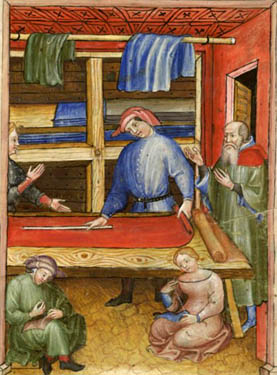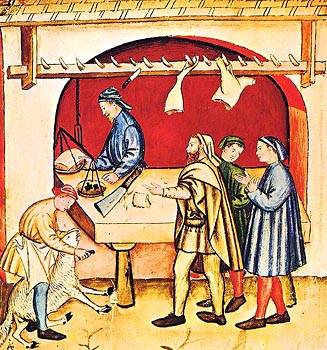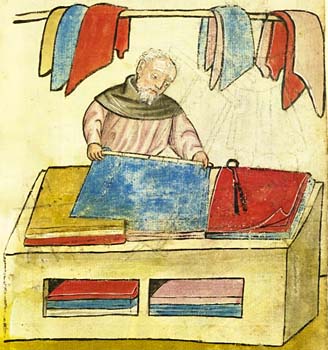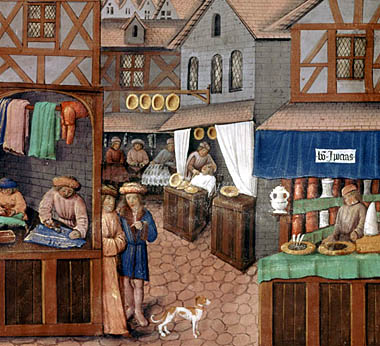Despite the strong bias of medieval artists and illustrators (or, more rightly, the patrons who commissioned works from them) towards religious and chivalric themes, a number of representations of stalls, shops, inns, and taverns, along with their proprietors, have survived to us. Some are incidental elements in works of broader scope, while others are themselves the subject of depictions illustrating some Biblical episode or story with moral lesson.
Somewhat outside of that genre, we are fortunate to have a number of versions of the Tacuinum Sanitatis, a handbook on matters of health and hygiene, which drew its text from an eleventh-century Arab medical treatise. From the late fourteenth century a number of lavishly illustrated copies was made, in Latin and then in vernaculars, first in Italy before spreading across other European countries. They portray not only a wide range of food and non-food products (with well-being implications), but also their vendors and the contexts in which those vendors operated. Stylization in the depiction of shops across the various versions of the manuscript owes something to the direct influence of earlier versions on later copyists, who make adjustments to the arrangement of elements, sometimes omitting details or adding new ones (with only occasional deterioration of accuracy in consequence). But it is also indicative of the use of archetypes – that is, visual concepts reduced to basics in order to communicate more effectively by capturing the essence of a subject. Audiences across Europe would have recognized the key elements incorporated into the commercial establishments depicted.

(above) A clothier's shop; the shopkeeper (a draper or tailor)
uses an ell to measure out cloth from a bolt for a client, while apprentices are busy
sewing below the counter; at rear more cloth is stocked on shelving and samples
are displayed from a pole.
(below) A butcher's shop showing the shopkeeper weighing a joint for a customer, while
his assistant slaughters a sheep; note the support posts for the counter.
From the Tacuinum Sanitatis

The various versions of the Tacuinum Sanitatis give us, in total, quite a number of depictions of butchers' shops. Most make the point that such shops were not simply where meat was sold, but also where animals were slaughtered, outside the shop in the street (cows being despatched with a blow to the skull by a sledgehammer, smaller livestock had their throats cut). The slaughtering is often being done by an assistant, while the butcher carves up carcasses into joints; a variety of knives and cleavers are seen across the various depictions. This accustomed use of violence may help explain why butchers could prove a troublesome group to civic authorities. Some illustrations pay recognition to the need not to pollute the street with blood and entrails, and the butcher's assistant or wife is sometimes seen capturing these in a bowl, while in one case there is the suggestion of a trough that may have been used for draining blood. Skinning the carcasses would also have been necessary, although this is shown in only one illustration. The display of joints, and sometimes entire carcasses, hung from pegs or hooks above or within the shop is a consistent feature of almost all Tacuinum Sanitatis portrayals of butcher's shops, and much the same compositional elements are present in pictures of butchers in the Hausbuch der Mendelschen, and in other sources; this would appear to be the principal iconographic element of a butcher's shop, although their blades run a close second. The Tacuinum implies that butchers often specialized in particular types of meat (beef, veal, mutton, pork etc.), while some dealt in jellied or otherwise processed meats; I have not encountered any documentary evidence to confirm such specializations in England.
Another good source of illustrations of commercial contexts is the Hausbuch der Mendelschen Zwölfbrüderstiftung, a series of books containing portraits of various tradesmen and craftsmen who were admitted, and died, in a Nuremberg retirement home in the fifteenth and sixteenth centuries; they are visually commemorated in the performance of their former occupations; although the repeated use of a limited number of models lessens their value somewhat, their portraits were created soon after death, though the architectural/commercial contexts must derive from the artist's familiarity with such places in Nuremberg.

The shop of Kunz Dorenberg, who died in the Nuremberg retirement home
in 1443. Although described as a tailor, whose measuring-stick and scissors characterize
that occupation, he appears from the portrait to be more than a simple cutter of cloths
brought to him by clients; he evidently has a stock of cloth to sell, some stored atop
and beneath his counter, and others displayed from a pole above the counter.
From the Hausbuch der Mendelschen Zwölfbrüderstiftung

A shopping street, from an illustration in an early sixteenth century
copy of a French translation (1444) of Giles of Rome's De regimine principum.
Bibliothèque nationale de France, Arsenal
The shopping street of an ideal city, depicted above, in which shops are located in the street-facing ground floors of houses, though in some cases spilling out into the street, shows a deliberately chosen selection of businesses, rather than a grouping of one particular trade (which was more common in the Middle Ages). Those included are:
- a draper, who uses a pole for displaying some of his products – this common element in depictions of clothiers' shops perhaps functioned somewhat like a trade-sign;
- a skinner (furrier);
- a barber shaving a customer who is protected by a white cloth, the trade-sign of shaving-bowls are hung above his pentice and we see curtains that could be drawn to give clients privacy;
- an apothecary, with spices and a cone of rock sugar (not heavily consumed because expensive) on his counter, medicinal concoctions in jars on shelves at rear; what seems to be a sign attached to his awning advertises bon ypocras, in reference to the popular drink of hippocras, made from spiced wine sweetened with honey, and considered to have medicinal properties – often served at feasts as a digestive. However, written signs posted on shops are not otherwise evidenced, and this may in fact be a cartouche intended to represent a shopkeeper's cry announcing the availability of the drink at his establishment.
These businesses have been chosen to illustrate Giles' point that towns represent a superior form of community because providing for specialization of occupations that result in the availability of goods or services not generally obtainable in smaller communities (such as villages). The clothier is almost a de rigueur inclusion, since the cloth trade was the mainstay of commerce at this period – drapers, goldsmiths, and apothecaries seem to be the shops most frequently depicted in medieval manuscripts. Even more than the clothier, the furrier and spicer represent luxury trades. Selection of the apothecary and barber may also have been intended to reflect urban concerns with health and hygiene; ignored here are tradesmen who would have been more common but whose work created unsanitary conditions, such as butchers, dyers, or tanners.